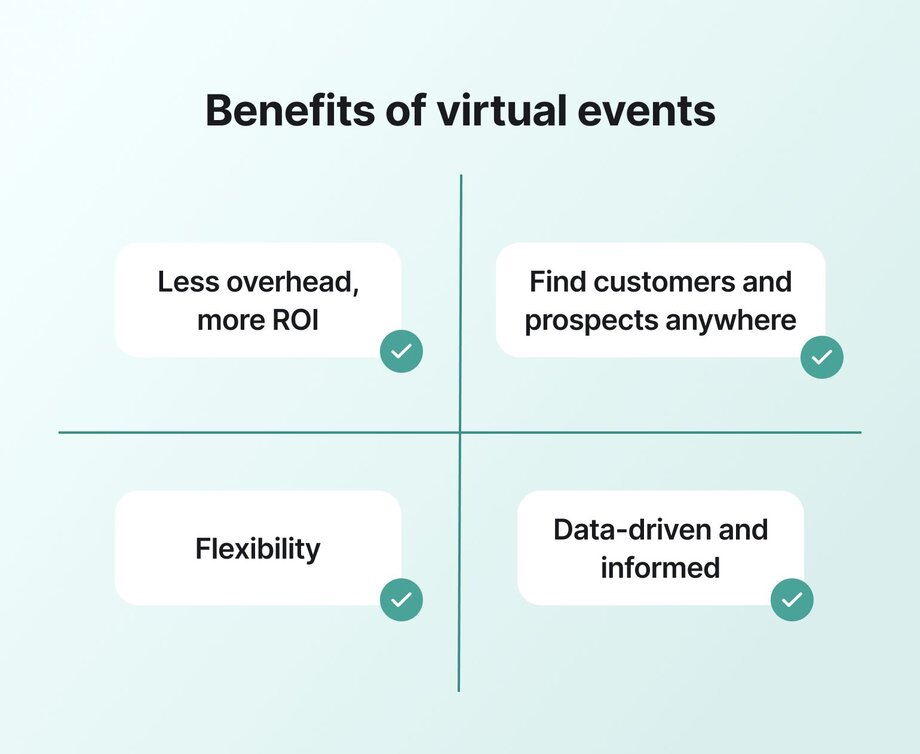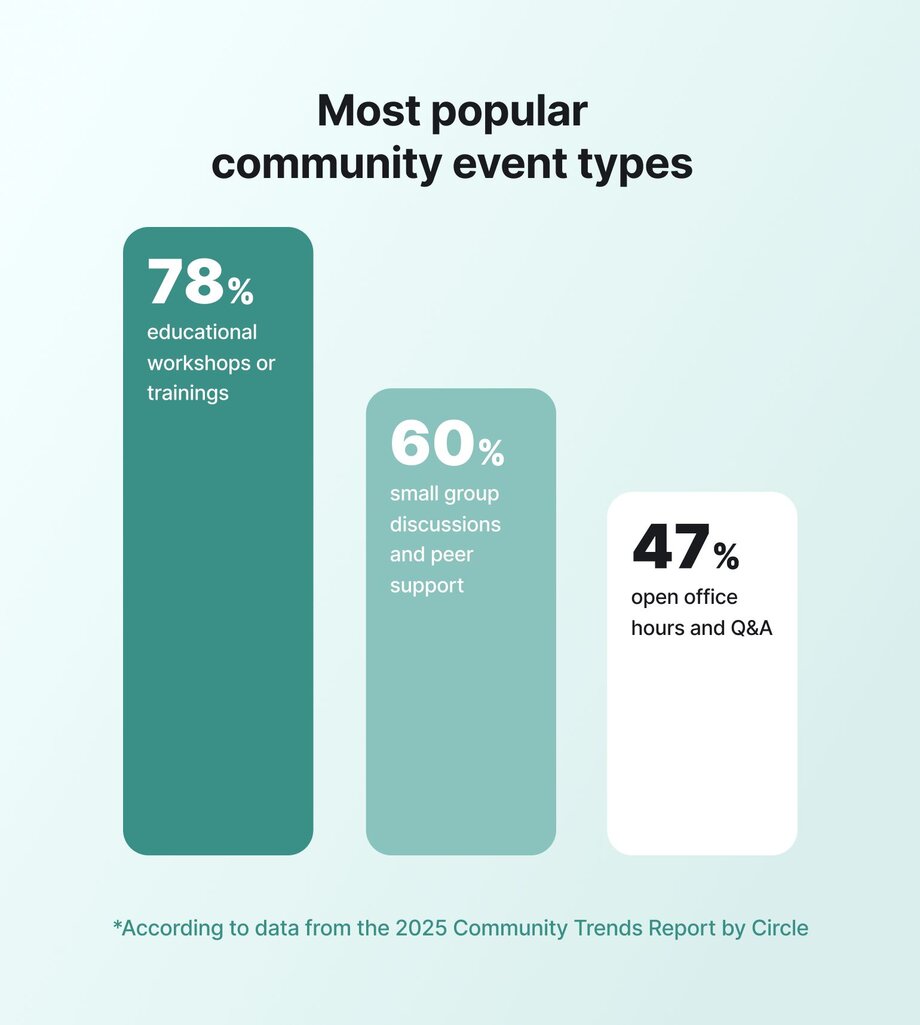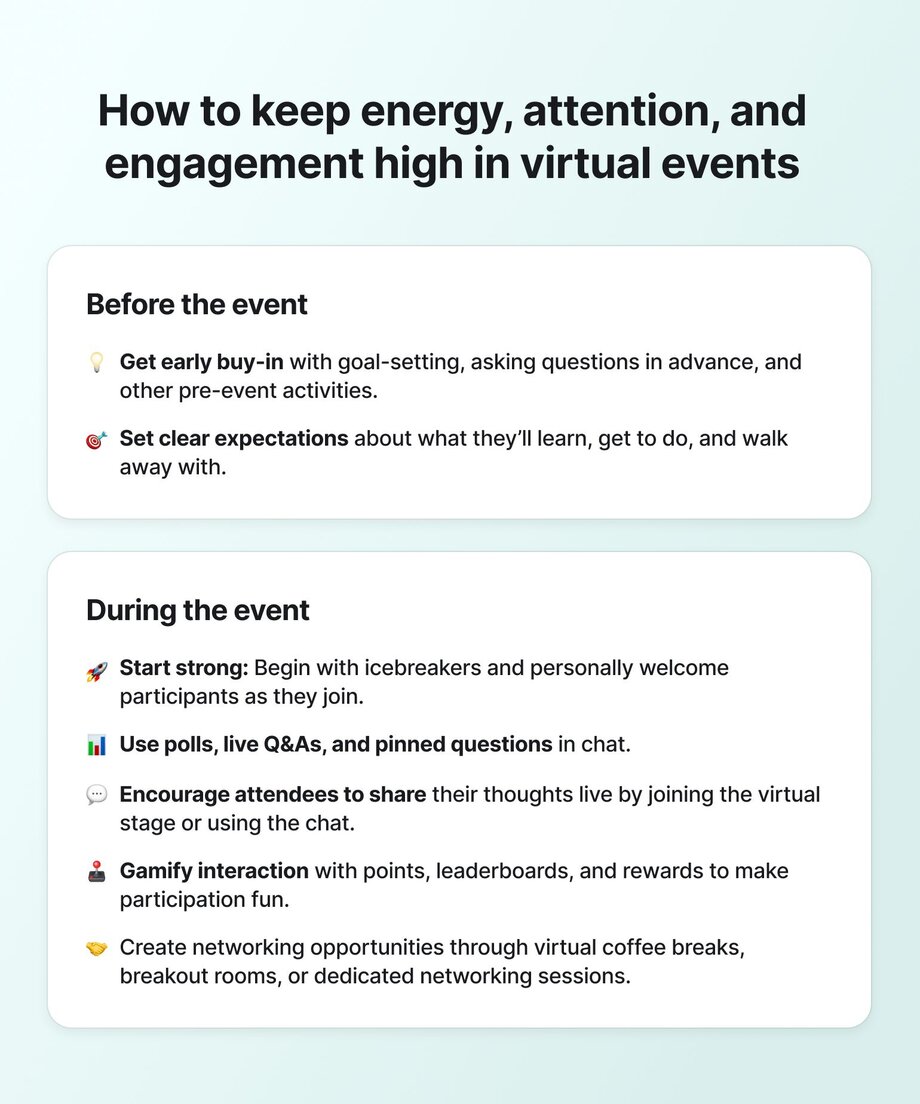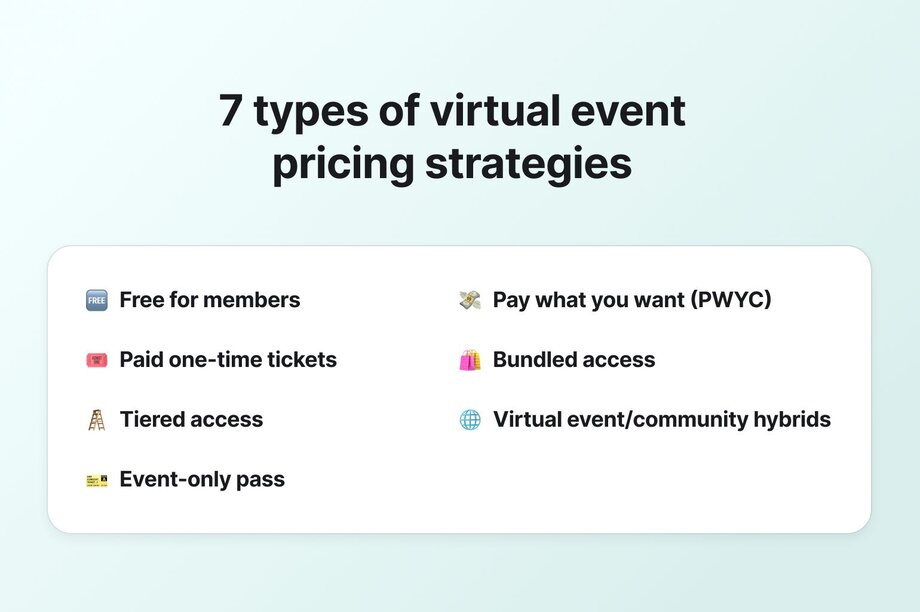How to plan, host, and scale unforgettable virtual events
At Circle, we run about 20 virtual events every month—that’s essentially one event every day of the week! On top of that, we also hold two multi-day summits and tactical boot camps per year, as well as countless webinars in our private customer community.
And here’s what we find interesting: even though on-demand content is practically everywhere, live events still have the spotlight. Our latest findings from the 2025 Community Trends Report show that more than 74% of our survey respondents said they find real value in live interactions within their communities.
“We talk about our summits like mini MBAs: they bring together the most relevant, fresh perspectives creators and entrepreneurs need to grow right now.”
- Alexis Teichmiller, Sr. Brand Partnerships Manager at Circle
It turns out that the energy of real-time interactions offers something special that you just can't get from pre-recorded content. This data shows us that having a variety of member experiences is essential, not just nice to have.
With experience powering up so many virtual events under our belt, we’ve seen firsthand what works, what doesn’t, and how communities can thrive when live experiences are done right.
Don’t worry—we don’t gatekeep. We made this guide, packed with actionable strategies for planning, hosting, and scaling virtual events, for you. Whether you're coordinating your first webinar or looking to refine your approach, you'll find valuable insights on using technology to create meaningful and engaging experiences.
Benefits of virtual events

Virtual events open up a world of new possibilities for your business. Here’s why they’re worth it:
💵 More value without the hassle: Eliminate the headache of venue hunting, travel drama, and catering chaos. Virtual events help you focus on meaningful moments without the overhead.
🌎 Invite the world: Break the constraints of physical venues. With virtual events, your audience is no longer limited by location. Wherever they are, everyone gets a front-row seat to your event.
🥂 Go hybrid: Virtual events can be synced with in-person ones to meet members where they are, both on the ground and online. In fact, according to our survey data, the most requested in-person events are basically just… hangs.
📊 See what works–immediately: Virtual events can help you build a data-driven strategy. By tracking which sessions capture attention, measuring participation in polls, and seeing which discussions ignite interaction, you get actionable insights that help you refine each event for even better future outcomes.
"The best thing we’ve done lately is using community data and analytics to inform our next masterclass topics. This helped drive higher RSVPs & attendance rates. One of the best examples is our latest (more requested) masterclass on ChatGPT for community builders."
- Mathilde Leo, Head of Community & Customer Education at Circle
Planning “can’t miss” virtual events–like a seasoned event pro
In 2024 alone, over 592,000 events were hosted on Circle—with more than 10 million active community members showing up across those spaces. That’s a 9% increase from the year before, and proof that people show up when events deliver real value.
Here’s how to ensure your virtual event is not just up and running but also impactful:
Decide on what you want attendees to get out of your event
Before you can think about anything else, you’ll need to get super clear on what your event will look like and how it will provide value to your members.
At a high-level, you’ll want to consider why you’re hosting the event.
- What goal do you hope to achieve through the event?
- Will you aim to educate, inspire, or connect your members?
- What value will you provide to members who attend the event?
“Your purpose for gathering should be ‘specific, unique, and disputable.’
The more it sounds like only your group could have such a gathering, the more special and celebratory it will feel. For example, ‘even though we're a buttoned-up professional community, we also want to get weird and play games together’ is a better purpose than ‘to celebrate November birthdays’.”
- Tatiana Figueiredo, community business strategist and founder of Friendly Nooks
Pick the right format for the job
The type of virtual event you choose lays the groundwork for your planning. Each format serves different purposes and audiences:
💻 Webinars: Perfect for large audiences, these focus on delivering educational content with opportunities for live Q&A. (They can also be fantastic lead magnets for bigger offers!)
🕓 Office hours: Less formal, these allow direct interaction with experts for personalized advice and Q&A.
👥 Small group discussions: These sessions encourage in-depth discussions on specific topics in a cozy, intimate setting.
🏅Member showcases: Highlight the achievements or projects of community members to inspire and motivate others.
📚 Onboarding and orientations: Essential for helping new members get up to speed with community norms and resources.
💡Workshops: Hands-on, interactive sessions where participants learn practical skills and techniques.
🌐 Summits and conferences: These are multi-session events that cover a wide range of topics, ideal for extensive knowledge sharing across a large audience.
“Summits are one of the best ways to build your brand online. You're facilitating value and connection that people don't have to pay for.”
- Alexis Teichmiller, Sr. Brand Partnerships Manager at Circle
At Circle, our approach varies: our Masterclasses attract many attendees looking for strategic insights, while our Show and Tells are great for engaging our customers with real peer examples and honest storytelling. Our Office Hours, though smaller, pack a punch with individualized interaction and targeted problem-solving.
Thankfully, it’s aligned with what people have told us they really want in our 2025 Community Trends Report:

👉🏽 Not sure which format to try next? Here are 7 types of virtual events to help you match structure to your community goals.
Set your business and community goals
Now that you have your format and your purpose, you’ll want to define what you want to accomplish for your business or community with the event: are you looking to boost brand awareness? Generate leads? Enhance community engagement?
Then, establish Key Performance Indicators (KPIs) to measure your event’s success and ensure it’s doing what you need it to do. For example:
- Registration numbers tell you whether your topic, title, and hosts are engaging
- Participant activity during the event can help you gauge engagement and timing
- Post-event feedback scores help you see if you’re providing true value to attendees.
⚡️ Pro tip: Circle’s in-app analytics show you exactly when most of your members are online to help you schedule events without the headache. Automated reminders (thanks to workflows) then help people add it to their calendar, and show up on time!
Pick your event platform
😫 Choosing the wrong virtual event platform can make or break your event.
You might encounter anything from clunky interfaces to laggy streams, confusing logins, and limited interaction tools. Although it’s impossible to avoid tech issues forever, it’s something to consider from your attendees' shoes: they came to the event for insights, not the lag time.
That’s why you should choose a platform that offers seamless streaming, straightforward navigation, and interactive tools like live polls, Q&A sessions, and networking capabilities to keep everyone involved and engaged from start to finish.
Platforms like Circle are designed to create high-impact, interactive experiences, offering tools for real-time engagement such as polls and live Q&A, which can significantly increase attendee involvement and satisfaction. A robust platform like ours can ensure event hosts feel capable, supported, and at ease and all attendees have to do is click “join now”–no matter whether they’re at home on the couch or on the go watching from their phone.
Plan your agenda like a dinner host
Crafting your event agenda is like planning a dinner party.

Just as a host plans each course to delight guests, your event schedule should thoughtfully guide attendees through an engaging, flexible experience:
- The welcome aperitif: Your opening sets the tone, so begin with a warm, brief introduction that orients everyone immediately. Like a quick welcome drink, it should energize attendees and clarify what they'll experience.
- Appetizers as icebreakers: Jump quickly into a high-impact insight that validates their decision to attend. Keep it under 10 minutes but make it substantial enough to engage.
- The main course: Position your most valuable, substantive content at the heart of your event–but keep it condensed and concentrated to account for online distractions. This is where you deliver on your core promise–the transformative insights, connections, or skills attendees came for.
- Palette cleansers: Schedule short breaks or energizing activities between main elements of your events–both to help attendees absorb what they've learned before moving on, and to refresh people’s attention without disrupting flow.
- Side dishes as breakouts: If you’re offering choices, limit options to just one or two highly relevant alternatives that directly support your main objectives.
- The dessert experience: End with a clear, actionable conclusion and next steps. Like a memorable small dessert, it should be satisfying while prompting anticipation for what comes next.
- After-dinner drinks: Pat Flynn of SPI calls this his “hallway epiphany”, where he realized that these informal moments often lead to the most meaningful connections and commitments. (It’s also the reason he created a community in the first place!)
“At Circle Summits, we stopped doing keynote after keynote. Now, we rotate between keynotes, panels, fireside chats, and workshops to keep the energy up and cater to different learning styles.”
- Alexis Teichmiller, Sr. Brand Partnerships Manager
Like any good host, remember to consider the rhythm and pacing, ensuring no one leaves either hungry for more substance or overwhelmed by too much content served too quickly.
How to keep energy, attention, and engagement high in virtual events
Without the physical cues and interactions of in-person settings, virtual events require strategic planning to maintain audience attention. Here's how to create an engaging experience:
Before the event:
- Build pre-event commitment: Encourage early investment through pre-event activities, personal goal-setting, and inviting attendees to submit questions in advance.
- Set clear expectations: Remind participants about the interactive opportunities they'll have during the session to build anticipation.
During the event:
- Start strong: Begin with icebreakers and personally welcome participants as they join to establish connection immediately.
- Use interactive tools: Use polls, live Q&As, pinned questions in chat, and real-time recognition to transform passive viewers into active participants.
- Invite direct participation: Encourage attendees to share their thoughts live by joining the virtual stage or using the chat function.
- Incorporate gamification: Add game-like elements such as points, leaderboards, and rewards to make participation fun and competitive.
- Create networking opportunities: Design virtual spaces that mimic in-person networking through virtual coffee breaks, breakout rooms, or dedicated networking sessions.

Measure to understand what a successful virtual event looks like
To understand how your events impact members, overall community engagement, and what you should consider changing, ask yourself these questions:
- Are people signing up and showing up? A high turnout means your community is actively interested.
- Are they chatting, asking questions, or using emojis? What’s the general sentiment during the event?
- What are they saying afterward? Collect direct feedback to understand what’s working and what’s not.
- Are they coming back for more events? Returning attendees suggest your events are keeping people interested.
- Do people engage, sign up, contribute, or refer others more after the event? These spikes will give you hints about the impact and value members find in your events.
- Do attendees take your recommended next steps after the event? Whether that’s checking in with an accountability group, signing up for a next event, or some other action–it’s insightful to see how folks continue engaging.
“Success isn’t just measured in attendance numbers; it’s in engagement, impact, and how the conversation continues after the event.”
- Pedro Hernades, Sr. Community Manager at Circle
How to monetize virtual events in the short–and long-term
Should you charge for your virtual events?
Short answer: it depends. 🤷♀️
The key is to balance profitability, effort, and community engagement.
Paid vs. free events
Just as you meet people where they already gather on social media before inviting them into your private community, free and paid events each serve distinct but complementary purposes in your engagement strategy.
Free events are open to anyone and can significantly boost your event's reach. They're perfect for building brand awareness and community goodwill. While attendance may be high, these events don’t always convert to paying customers, community engagement, or loyalty.
Paid events ask for a layer of commitment from attendees, which can filter the audience to those most interested or invested in the topic. They can help fund deeper, higher-value experiences and create a revenue stream for your community.
Because paid events have a higher barrier to entry, they’re an incredible way to offer a curated, controlled taste of what your community has to offer without giving them access to everything.
So don’t be afraid to get creative with how you offer access to guests, such as offering free events embedded within paid memberships or ticketing events like in-person meetups or conferences separately, with special discounts or perks for existing members.
Real success story: how Lattes and Leases ran a summit to launch her membership
Soli Cayetano is a real estate mogul, investor, educator, and community builder. When she attended a Circle Summit several years back, she realized, ‘I need to do this for my business.’
“She ran a free, 2-day summit, partnered with big-name real estate creators, and launched a membership after the summit—with 400 paying members,” shares Alexis.
7 Creative ways to price your virtual events
Different ways to approach event ticketing can help you earn more and build a solid funnel for your community or creator business.
- Free for members: Ideal for subscription communities seeking to boost retention and engagement. Adding exclusive events makes members feel they're getting continual value from their subscription.
- Paid one-time tickets: Best for high-effort events like summits or bootcamps. Use this when you want to monetize beyond your existing community or test demand for future products without changing your membership pricing.
- Tiered access: Perfect for communities with multiple membership levels. Make events free for premium members but charge others, encouraging upgrades while keeping events accessible to more people.
- Event-only pass: Great for limited-time experiences like challenges or cohorts. Offers a low-commitment way for people to experience your community, often leading to full membership conversions.
- Pay what you want (PWYC): Works best for mission-driven communities (or yoga classes!). Builds goodwill and inclusivity while allowing you to test price sensitivity or raise funds for special initiatives.
- Bundled access: Ideal for creators with multiple offerings. Packaging event access with courses or digital products increases perceived value and can boost conversion rates during launches.
- Tatiana Figueiredo , a Circle expert and community business strategist, offered free, weekly live office hours and Q&A sessions (“hot seats”) to co-create and refine her curriculum for her course—before it was even created!
- Virtual event/community hybrids: Best for creating sustainable growth pipelines.These models are popular among creators like Julie Solomon, Ali Abdaal, and others who host free webinars to promote a course or community launch. This creates natural pathways from casual interest to committed community membership.

Real success story: how events power a VIP community
In Foundr+, a membership community for 3,000+ e-commerce founders, live events are a core value proposition that justifies the membership price. Their event engine keeps members engaged (at a baffling 73% attendance rate), directly supporting a multi-million dollar annual revenue stream. Foundr’s case shows how integrating virtual events into a subscription community can scale into a substantial and sustainable income source. Within Foundr+, live events (expert workshops, Q&A sessions, coaching calls) happen every week to engage members. They also offer a higher-tier coaching program (about 400 members get 1‑on‑1 mentorship) on top of the standard membership.
Learn more in their community show & tell:
Adding event partners or sponsorships
Forging partnerships with brands that align with your event’s theme can add value and help fund your events. Think guest speakers, co-branded content, or exclusive offers.
But, a note of caution: When bringing in partners and sponsors, ensure they feel additive, not intrusive to your agenda. Here are our best practices for event partnerships:
Find the complementary audience overlap. Without insight into your attendees, you won’t be able to convince others that partnering is a good use of their time and/or money. Use registration forms, post-event surveys, and analytics tools to build detailed audience profiles that demonstrate the value of your audience.
Look for genuine brand alignment rather than just pursuing big names. The most successful partnerships come from authentic connections between your event's purpose and a sponsor's mission. Attendees can easily spot forced partnerships that feel purely transactional.
Offer unique opportunities. Virtual events enable innovative sponsorship activations that are impossible in physical settings. Consider offering sponsored breakout rooms, gamified challenges with sponsor-provided prizes, or exclusive digital content collaborations that provide tangible value to attendees while highlighting sponsor expertise.
Demonstrate clear ROI metrics and establish feedback mechanisms. The most important part of a partnership? The retro, post-event report. Establish regular check-ins during the planning process to incorporate sponsor input and ensure they’re aligned.
Upsell what you already offer
Use your virtual events to promote memberships, courses, coaching… or other upcoming events! Your audience is already engaged, making them more likely to invest in additional offerings — it’s the perfect time to invite them deeper into your ecosystem.
⚡️ Pro tip: Don’t think of it as a hard sell! Exploring other offerings is naturally the next step for people who already see the value you bring.
Turning one-off events into long-term community
Virtual events aren't just isolated experiences—they're powerful gateways to building lasting community. If you're thinking about how to create a drumbeat of high-impact programming for your members, check out our guide on how to host community events that deepen engagement over time.
Events create natural touchpoints that subscription-based communities often struggle to establish. Unlike passive content consumption, live events generate:
- Shared experiences that bond participants through collective learning and discovery
- Identity formation as attendees begin to see themselves as part of something larger
- Relationship networks that extend beyond the host-to-member dynamic
Data from our trends report confirms what many successful community builders already know—the energy of real-time connection offers something special that pre-recorded content simply can't replicate.
So how do you build the event-to-community pipeline?
The most successful communities treat events not as one-off marketing tactics but as core infrastructure. Here's how to build your event engine:
- Develop event series rather than standalone sessions, creating natural follow-through
- Diversify formats to appeal to different learning styles (our report shows the popularity of varied formats from Q&As to workshops to networking sessions)
- Establish rituals and traditions that members look forward to and identify with
- Capture and repurpose event content to extend value and create entry points for new members
- Design for both synchronous and asynchronous participation to accommodate different schedules
Foundr+'s impressive 73% attendance rate stems from precisely this approach—their events aren't supplementary but central to their community identity.
🫶🏼 Remember: The goal isn't just attendance but belonging. When members transition from thinking "I'm attending this event" to "I'm part of this community," you've successfully built the bridge.
“The success of an event isn’t in how many show up, but in how many feel seen, heard, and inspired when they leave.”
- Pedro Hernades, Sr. Community Manager at Circle
TLDR: Pro tips for hosting engaging community events
Boost engagement and keep your online audience hooked from start to finish with these top community event tips:
- Nail your niche: First things first—what’s your weird? By focusing on what makes you stand out, you ensure that your activities and content resonate specifically with the right audience.
- Craft invitations they can't ignore: Write clear, compelling invitations that outline the event’s purpose, setting expectations and highlighting benefits. This will build anticipation and boost attendance.
- Engage from the start: The first five minutes are crucial. “Your energy as a host matters. Be human. Be confident. Mistakes happen, but how you show up in that moment builds connection,” says Alexis.
- Connect the dots early: Encourage interaction among attendees from the beginning with activities like prompt questions or breakout groups. “Focus on the attendee experience. Help them connect—with content and with each other,” says Alexis.
- Balance the buzz: Avoid overwhelming your guests with too much information. Focus on creating digestible, interactive sessions that promote participation and discussion.
- Reflect and connect: Allow time for attendees to reflect on what they’ve learned and to share their thoughts. This enhances their understanding and builds personal connections.
- End with a bang: Conclude your events intentionally with a final sharing session or a memorable activity to leave a lasting impression.
What we’re looking forward to in virtual events
Some trends are already here, and others are picking up speed fast. Here’s what’s realistic to expect by 2030 (and why):
AI that actually helps
AI is already simplifying event planning: automating scheduling, generating content suggestions, and handling follow-ups. Over the next few years, expect smarter tools that adapt in real-time to attendee behavior—recommending sessions, surfacing relevant questions, or flagging engagement drop-off mid-event.
Note-taking features will get smarter, too—summarizing key moments, tracking action items, and even syncing to follow-up workflows. Communities of all sizes will also use AI to analyze post-event chat, poll responses, and feedback to uncover patterns, interests, and future content ideas they might otherwise miss.
The future isn’t AI vs. community—it’s AI and community. The builders who thrive will use AI thoughtfully, freeing up time to focus on the one, irreplaceable thing it can’t replicate: human connection.
- Circle's Trend Report 2025
Hybrid as the default
In-person won’t go away—but it’s not always realistic or inclusive. Hybrid formats let you do both. Expect tools to better blend the two experiences seamlessly with smoother tech, better analytics, and more flexible attendee paths.
Immersive experiences in small, smart doses
Will every event be hosted in the metaverse in five years? Maybe not. But immersive experiences are getting more practical—especially in high-value or high-stakes formats. Think onboarding new members with interactive walkthroughs or sending physical kits that pair with virtual workshops.
More personal, less one-size-fits-all
Attendees expect personalized content that meets their goals. The tech is catching up. Soon, you’ll be able to adjust sessions based on a participant’s role, behavior, interest, or learning goals more easily.
Sustainability becomes a driver
With travel budgets tightening and climate impact under more scrutiny, virtual and hybrid events won’t just be convenient—they’ll be necessary. Platforms will start highlighting their environmental impact as a feature, not a bonus.
From events to community ecosystems
“Live events are thriving because they bring an irreplaceable sense of human connection and energy that more static digital interactions can't match. They create shared experiences and help members feel like they're part of something bigger—something real.”
- Sid Yadav, co-founder and CEO, Circle
Virtual events aren’t a temporary fix—they’re part of the future of community building. As tech improves and member expectations shift, the most successful events will focus on genuine connection, flexibility, and long-term value.
Check out Circle’s community analytics to monitor activity, engagement, and traffic—and if you’re not a customer yet, start your free 14-day trial today.